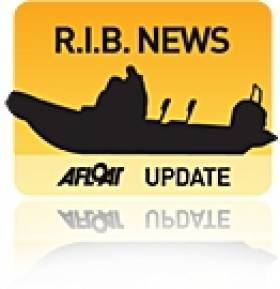Displaying items by tag: Zodiac RIB
MGM Boats describes the new Zodiac Open 5.5 that has recently landed at the boatyard in Dun Laoghaire Harbour as the 'Swiss army knife of boats'.
As regular Afloat readers will know, MGM Boats became Irish Zodiac distributors last December. In announcing the new distributorship, Dublin Bay-based MGM Boats also launched a promotion on the new Open 5.5 metre RIB, a popular size model in Ireland and this March arrival makes good on that promise.
With its excellent sea-keeping performance – thanks to its deep V-hull and its optimised deck plan, the Open is a great starter package and a lot more besides because it is pretty much at ease in all activities.
Thanks to its design, it is easily transportable, even with an inflated tube, it works for getaways, fishing, waterskiing, wakeboarding and sunbathing (we hope!)
The new 5.5 has a Deep V fibreglass hull and a self-bailing deck. Full spec here.
More details from MGM Boats here.
RIB Maker Continues to Expand
#ZODIACRIBS – Rigid Inflatable manufaturer Zodiac continues to evolve its range of RIBs, inflatable boats, tenders and liferafts with the some new concepts, new hulls and designs.
In addition to displaying three new models for the first time at today's Tullett Prebon London Boat Show, including the Cadet 310 Neo, Pro Classic 420 and the Yachtline Deluxe 420, Zodiac® has recently introduced a new, luxurious Medline range of boats as well as adding three new tenders to the Zoom range. To maintain their position as a worldwide leader in the manufacturing and distribution of Ribs, Zodiac® has also renewed its N-ZO, Pro, Pro Open and Cadet Ribs, ranges to give its customers more choice.
Trevor Newton-Walker, Customer Services Manager of Zodiac commented: "Our customers have a huge array of requirements when it comes to choosing the right boat, Rib or tender and Zodiac® is constantly striving to offer as many options as possible. This year alone we have added six new boats from 5m to 7.60m, eight new Cadet Rib models to many of our ranges and have re-designed seven boats so they can give the best performance possible when out on the water. Zodiac will continue to extend the possibilities for its customers in addition to leading the way in the design and manufacturing of RIBs".
The recent renewal of the Medline range with the Medline 500, 540 and 580 highlights Zodiac's® capabilities in creating a boat that makes sailing as stress free as possible both at sea and on land. Equipped with spacious sundecks and depending on the model size, a large aft bathing platform, this new range, complemented by new hulls, a new design and new tubes has been created to optimise time spent on-board.
Following the theme of luxury on-board, Italian designer Vittorio Garroni has once again used his exceptional talent to develop the new N-ZO 600, 680 and 760 with the needs of recreational boat owners in mind. Meeting necessary technical specifications and featuring exclusive lines, the N-ZO range is designed to offer passenger safety and comfort.
The ever popular Pro and Pro Open ranges have both been updated and re-designed to offer more options to customers and continue to be the perfect boats for water sports, fishing and relaxing. The models in the Pro range are now offered with a variety of tube designs and a choice between PVC or Hypalon™-Neoprene™ fabric in addition to a wide choice of colours. The re-designed Pro Open range incorporates bright and energetic accents of colour while the 550 is now equipped with a rear passenger seat which will safely and comfortably seat three passengers.
Purchasers of the Zodiac® Pro Classic 420, displayed at the Boat Show, alongside other models in the Sports Cruising Range have the option to customise the deck layout of the boat with various seat and console options to suit their individual requirements. Users are also offered a choice between a white or grey polyester hull and matching accessories. Available in red or black PVC or grey Hypalon™-Neoprene™, depending on the model, the Pro Classic was designed to offer unparalleled safety on board and includes a non-slip deck. The Pro Classic 420 offers a high load capacity, seating up to seven passengers.
Also on display at the London Boat Show is the Zodiac® Yachtline Deluxe 420, part of a sleek, attractive range of tenders, perfect for any yacht user. It now offers a choice on Hypalon™- Neoprene™ tube colours including white/blue, white/camel and white/grey. The tender has been designed with ultimate comfort in mind and can accommodate up to six people. The hull has been adapted to work in conjunction with heavy 4-stroke motors and bow rise is minimal making it incredibly easy to manoeuvre. In keeping with the beautiful design, all of the fittings on board, including the bow rail and mooring cleats are made from stainless steel.
Accommodating up to five people, the Zodiac® Cadet 310 Neo is equipped with a medium 'V' shaped fibreglass hull to provide excellent performance on the water. The large diameter buoyancy tube is available in Strongan™, an incredibly tough and durable fabric or Hypalon™- Neoprene™, which has a high shock absorbency and both provide advanced stability. Both materials are extensively tested to prove that it is seaworthy in all conditions, including exposure to UV rays in tropical conditions. The anti-skid fibreglass deck, combined with the bow storage locker makes it one of the most safe, comfortable tenders to sail, even in choppy waters.
Capitalising on its experience at sea, Zodiac® has expanded the Zoom range with three new dinghies including the Zoom 200 Roll Up, Zoom 260 Roll Up and Zoom 230 Aero. Known as a compact, robust range, the extension to the models already on offer presents customers with an affordable, safe option when sailing.
Zodiac® vessels are synonymous with style and safety. For more information please visit stand H105 at the Boat Show

























































